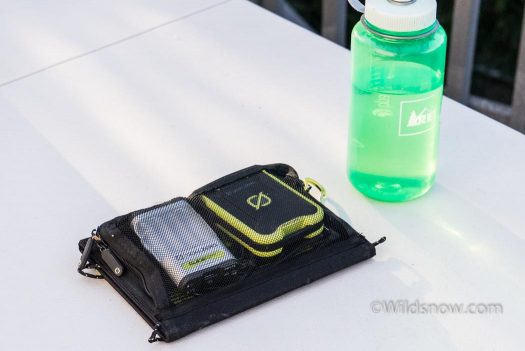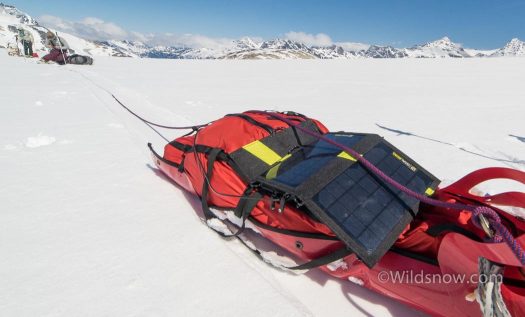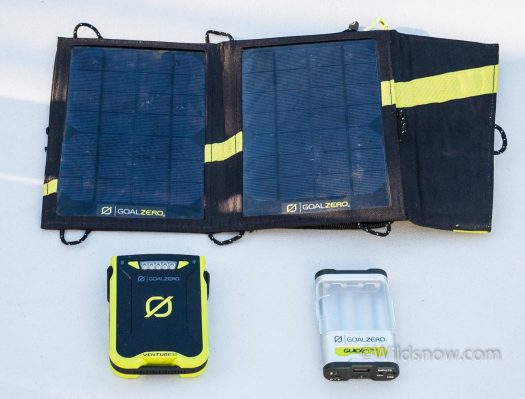Late this spring, a few friends and I did a ski traverse and ski mountaineering trip on the Monarch Icefield, in western British Colombia. This was a somewhat new type of trip for me; rather than a stationary aircraft assisted camp, we were fully self-sufficient for 15 days of rough travel through glaciers, thick forests, and high peaks.
Although such an adventure is an escape from civilization, we couldn’t leave all our modern devices behind. We brought along a number of battery operated tools to make the trip smoother, and to add a bit of comfort. A lightweight solar charging setup was needed to keep everything running.
Here’s a list of the electronics we brought and their power source:
Whew, lots of stuff!
The sat phone is a no-brainer. We used it for weather updates, as well as having it for emergencies. The SPOT messenger was a backup for the satphone, as well as a fun way to let folks know what we were up to.
The iPhones might seem excessive, but they were our main GPS navigation devices. I’ve found a good GPS app to be much better than a stand-alone GPS. We stored beta and guidebook photos on our phones. Although less essential, they provided music and entertainment. I used mine for journaling and note-taking.
Just in case, we took a small Garmin GPS as a backup device.
I’ve found 2-way radios to be invaluable on trips like this, adding safety and flexibility. The other items are self-explanatory.
Most items either had the ability to be charged directly via USB, or used rechargeable AA or AAA batteries. A few, namely the beacons and SPOT Messenger, aren’t supposed to be used with rechargeable batteries. I tested both before the trip, and they did work with rechargeable batteries, good to know for emergency battery replacement — but we operated those devices using their recommended battery type.
For our solar panel, we used the Goal Zero Nomad 7. This is the second smallest panel that Goal Zero makes, and the smallest that can charge a majority of devices. It measures 9×17 inches, and folds in half for storage. It has three outputs: a female USB cord, and two proprietary goal-zero cables. Weight: 16 oz.
We also brought a Venture 30 battery pack and a Guide 10 recharger. The Venture is simply a 29WH lithium battery with 2 USB ports and a built-in flashlight. It’s about 4x3x1 inches, and weighs 9 oz. The Guide 10 can charge AA and AAA batteries, and also acts as an external charger, via a USB port. A selection of AA and AAA rechargeable batteries, and all the required cables to charge our various devices completed our kit.
The Venture 30 is a fairly large battery pack, and Goal Zero recommends a larger solar panel to charge it in a reasonable amount of time. Instead, I figured that with the ultra-bright “sun bowl” environment of an icefield, coupled with long days and having the panel strapped to my sled while traveling, we would get efficient and perhaps even enhanced power coming out of the panel. This turned out to be the case and we had plenty of reserve power.

Packed up: the battery and charger fit neatly into the pocket on the back of the solar panel. Water bottle for scale.
The setup weighed a fair bit when all together. However, it gave us major peace of mind, and was certainly lighter than only carrying a bunch of batteries. I was excited to see how it would actually work.
With the conditions we had, the Nomad 7 solar panel could charge the Venture 30 and the Guide 10 at the same time when we left them hooked up in camp, and we were able to use both to recharge our stuff when we returned in the evening.
Everything held up well throughout the trip. The solar panel is rugged and water resistant. However, since we were relying on it with no backup, I kept it inside the tent during storms. Even inside our tent it managed to charge, albeit only a trickle. It did get snow and water on it a few times and was fine.
Bear in mind that a solar panel only works well if it’s constantly facing the sun, or somewhat facing the sun but harvesting photos from reflected light. Thus, the idea of having a panel on your pack or sled has limited utility. Doing so is still worth trying — it was for us — but keep in mind that our system was designed for stationary use in camp.
In summary, this setup was an excellent choice for our Monarch ski traverse. It proved to be fully capable of keeping all our stuff charged, and kept the weight down to a reasonable level. Without it, we would have had to carry significant weight in batteries, and I probably wouldn’t have been able to bring my nice big camera (and get sweet pics).
Anyone else have experience using light solar systems for longer trips? I’d love to hear your thoughts about other configurations.
Backcountry.com has the Nomad 7 Solar Panel for 20% off right now, get it here. You can also get the Venture 30 battery here, and the Guide 10 recharger here.
Louie Dawson earned his Bachelor Degree in Industrial Design from Western Washington University in 2014. When he’s not skiing Mount Baker or somewhere equally as snowy, he’s thinking about new products to make ski mountaineering more fun and safe.


